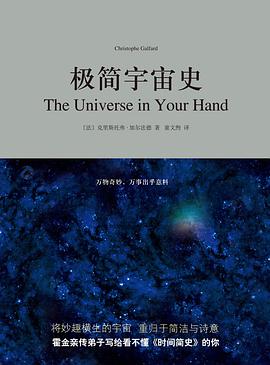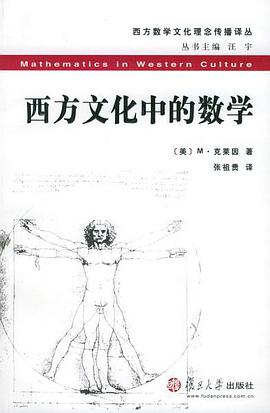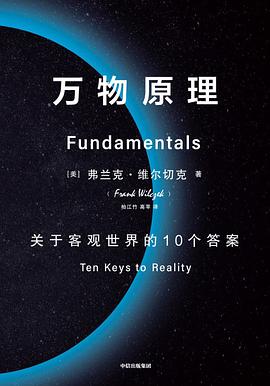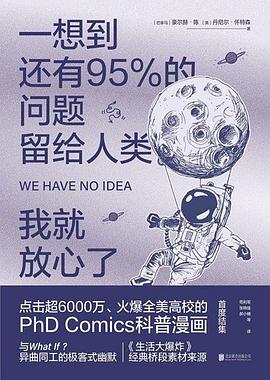物理
西方文化中的数学 豆瓣 Goodreads
Mathematics in Western Culture
9.6 (10 个评分)
作者:
[美] M·克莱因
译者:
张祖贵
复旦大学出版社
2004
- 4
《西方文化中的数学》是美国著名数学家、数学教育家、数学史家M·克莱因的一部力作。自1953年在美国出版后,多次再版,深受西方文化界、数学界欢迎,其影响经久不衰。《西方文化中的数学》系统地阐述了各个不同历史时期数学与文学、绘画、哲学、宗教、美学、音乐、人文科学、自然科学等文化领域的内在联系,详细而透彻地说明了数学对西方文化、理性精神、现代人类思想的发展所产生的深刻影响,有力地证明了数学是人类文化的重要组成部分和不可缺少的重要力量。
万物原理 豆瓣
Fundamentals:Ten Keys to Reality
作者:
[美]弗兰克·维尔切克(Frank Wilczek)
译者:
柏江竹
/
高苹
中信出版集团
2022
- 1
一位伟大的当代科学家揭示了十项深刻的洞见,阐明了每个人都应该了解的物理世界。
在《万物原理》一书中,诺贝尔奖得主弗兰克·维尔切克以现代科学的深刻启示为基础,对现实进行了简单而深刻的探索。世界是什么,它又是如何运作的?维尔切克通过清晰准确的叙述,加上一份富有感染力的愉悦感,引导我们探索了关于以上问题的理解的基本概念。读完这本书,我们将以一种新的方式来看待我们身处的现实——会发现,它比以前看起来更大、更完整、更陌生。
维尔切克综合了基本的问题、事实和令人眼花缭乱的推测,研究了那些形成我们对宇宙的理解的基础观念:时间、空间、物质、能量、复杂性和互补性。他挖掘基础科学的历史,探索我们知道什么以及我们是如何知道这些的,他带领我们在科学世界的视野中旅行。精彩、清晰、平易近人,这是一场凝聚人类智慧和想象力的盛宴,将扩展你的世界和思维。
在《万物原理》一书中,诺贝尔奖得主弗兰克·维尔切克以现代科学的深刻启示为基础,对现实进行了简单而深刻的探索。世界是什么,它又是如何运作的?维尔切克通过清晰准确的叙述,加上一份富有感染力的愉悦感,引导我们探索了关于以上问题的理解的基本概念。读完这本书,我们将以一种新的方式来看待我们身处的现实——会发现,它比以前看起来更大、更完整、更陌生。
维尔切克综合了基本的问题、事实和令人眼花缭乱的推测,研究了那些形成我们对宇宙的理解的基础观念:时间、空间、物质、能量、复杂性和互补性。他挖掘基础科学的历史,探索我们知道什么以及我们是如何知道这些的,他带领我们在科学世界的视野中旅行。精彩、清晰、平易近人,这是一场凝聚人类智慧和想象力的盛宴,将扩展你的世界和思维。
A Brief History of Time 豆瓣 Goodreads
A Brief History of Time: From the Big Bang to Black Holes
8.1 (11 个评分)
作者:
Stephen Hawking
Bantam
1998
- 9
Book Description
"A Brief History of Time", published in 1988, has been a landmark volume in scientific writing and in worldwide acclaim and popularity, with more than nine million copies sold. That edition was on the cutting edge of what was then known about the nature of the universe. Since its publication, however, there have been extraordinary advances in the technology of observing both the micro- and the macrocosmic world, confirming many of Professor Hawking's predictions. Eager to bring to his original text the new knowledge revealed by these observations, Hawking has written a new introduction, updated chapters throughout, and added an entirely new chapter on Wormholes and Time Travel.
"A Brief History of Time" has guided nonscientists everywhere to confront the supreme questions of the nature of time and the universe, taking them to distant galaxies, black holes, alternate dimensions — as close as man has ever ventured to the mind of God. This anniversary edition makes vividly clear why Professor Hawking's eloquent classic has transformed our view of the universe.
Amazon.com
Stephen Hawking, one of the most brilliant theoretical physicists in history, wrote the modern classic A Brief History of Time to help nonscientists understand the questions being asked by scientists today: Where did the universe come from? How and why did it begin? Will it come to an end, and if so, how? Hawking attempts to reveal these questions (and where we're looking for answers) using a minimum of technical jargon. Among the topics gracefully covered are gravity, black holes, the Big Bang, the nature of time, and physicists' search for a grand unifying theory. This is deep science; these concepts are so vast (or so tiny) as to cause vertigo while reading, and one can't help but marvel at Hawking's ability to synthesize this difficult subject for people not used to thinking about things like alternate dimensions. The journey is certainly worth taking, for, as Hawking says, the reward of understanding the universe may be a glimpse of "the mind of God."
--Therese Littleton
From Library Journal
A new edition?with pictures?for those who couldn't fathom the original.
About Author
Stephen Hawking, who was born on the anniversary of Galileo's death in 1942, holds Isaac Newton's chair as Lucasian Professor of Mathematics at the University of Cambridge. Widely regarded as the most brilliant theoretical physicist since Einstein, he is also the author of Black Holes and Baby Universes, a collection of essays published in 1993, as well as numerous scientific papers and books.
Book Dimension :
length: (cm)22.8 width:(cm)15.5
点击链接进入中文版:
时间简史(插图本)
注:该书有2个封面内容完全一致,货品随机发送
"A Brief History of Time", published in 1988, has been a landmark volume in scientific writing and in worldwide acclaim and popularity, with more than nine million copies sold. That edition was on the cutting edge of what was then known about the nature of the universe. Since its publication, however, there have been extraordinary advances in the technology of observing both the micro- and the macrocosmic world, confirming many of Professor Hawking's predictions. Eager to bring to his original text the new knowledge revealed by these observations, Hawking has written a new introduction, updated chapters throughout, and added an entirely new chapter on Wormholes and Time Travel.
"A Brief History of Time" has guided nonscientists everywhere to confront the supreme questions of the nature of time and the universe, taking them to distant galaxies, black holes, alternate dimensions — as close as man has ever ventured to the mind of God. This anniversary edition makes vividly clear why Professor Hawking's eloquent classic has transformed our view of the universe.
Amazon.com
Stephen Hawking, one of the most brilliant theoretical physicists in history, wrote the modern classic A Brief History of Time to help nonscientists understand the questions being asked by scientists today: Where did the universe come from? How and why did it begin? Will it come to an end, and if so, how? Hawking attempts to reveal these questions (and where we're looking for answers) using a minimum of technical jargon. Among the topics gracefully covered are gravity, black holes, the Big Bang, the nature of time, and physicists' search for a grand unifying theory. This is deep science; these concepts are so vast (or so tiny) as to cause vertigo while reading, and one can't help but marvel at Hawking's ability to synthesize this difficult subject for people not used to thinking about things like alternate dimensions. The journey is certainly worth taking, for, as Hawking says, the reward of understanding the universe may be a glimpse of "the mind of God."
--Therese Littleton
From Library Journal
A new edition?with pictures?for those who couldn't fathom the original.
About Author
Stephen Hawking, who was born on the anniversary of Galileo's death in 1942, holds Isaac Newton's chair as Lucasian Professor of Mathematics at the University of Cambridge. Widely regarded as the most brilliant theoretical physicist since Einstein, he is also the author of Black Holes and Baby Universes, a collection of essays published in 1993, as well as numerous scientific papers and books.
Book Dimension :
length: (cm)22.8 width:(cm)15.5
点击链接进入中文版:
时间简史(插图本)
注:该书有2个封面内容完全一致,货品随机发送
一想到还有95%的问题留给人类,我就放心了 豆瓣 Goodreads
We Have No Idea: A Guide to the Unknown Universe
7.9 (22 个评分)
作者:
[巴拿马] 豪尔赫•陈
/
[美] 丹尼尔·怀特森
译者:
苟利军
/
张晓佳
…
北京联合出版公司
2018
- 12
这是一本“逆向科普”的科普书。你以为你知道的事情,其实连世界顶尖科学家都不知道。这本书告诉你那些“顶尖科学家都不知道的事情” 。但这并非一本“答案”之书。本书旨在告诉你人类最前沿科学的边界,带领你一起从未知探索到已知。
这是一本趣味和严谨并存的科普书。一个科学家,放弃科研,改画漫画。20年后,他邀请一位顶尖科学家共同创作了这本“科普未知”的科普书。
这是一本你不看就会“落伍”的科普书。为什么“黑洞” “暗物质” “暗能量”“宇宙”“平行空间”等概念对人类有着深深的吸引力?那是因为它们是“未知”的。只有未知的事物才能勾起人类强大的好奇心而好奇心正是人类发展的源动力。
这是一本趣味和严谨并存的科普书。一个科学家,放弃科研,改画漫画。20年后,他邀请一位顶尖科学家共同创作了这本“科普未知”的科普书。
这是一本你不看就会“落伍”的科普书。为什么“黑洞” “暗物质” “暗能量”“宇宙”“平行空间”等概念对人类有着深深的吸引力?那是因为它们是“未知”的。只有未知的事物才能勾起人类强大的好奇心而好奇心正是人类发展的源动力。




